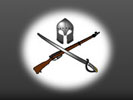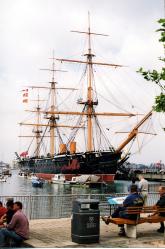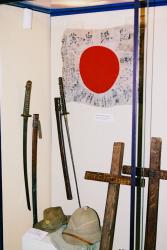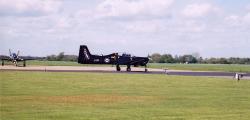Translate this Page
Cape St. Vincent
Battle Name : Cape St. Vincent
Date(s) : 14 February 1797
Part of : The French Revolutionary and Napoleonic Wars , French War of the First Coalition ,
Outcome : A victory for British Fleet over Spanish Fleet
Type of battle : Sea
Summary
A Spanish fleet of 27 ships-of-the-line under Admiral Cordoba were intercepted by a British fleet, 15 ships-of-the-line, under Sir John Jervis. The British attacked and took five of the Spanish ships. Nelson in H.M.S. Captain played a significant part in shaping the battle. A significant British victory.
Location
The action began about 24 to 30 miles southwest of Cape St. Vincent. The fleets manoeuvred in an area to the north of this position. Cape St. Vincent [C, Sao Vicente] is on the Atlantic coast of Portugal about 120 miles south of Lisbon.
More details
The French strategic plan in early 1797 was for the Spanish fleet, the French fleet and the Dutch fleet to link up and thereby dominate the Channel. A French invasion force would then be able to cross directly to England. The Dutch fleet were lying in the Texel. The French under Vice-Admiral de Galles were lying in Brest, and the Spanish fleet under the newly appointed, Vice-Admiral Conde de Cordoba, lay in Cartagena. At this time the British did not have a significant presence in the Mediterranean but Vice-Admiral Jervis had a fleet of ten ships watching for any Spanish breakout from the Med or from Cadiz. The fleet of Spaniards sailed from Cartagena on the 1st February and passed through the Strait of Gibraltar on the 5th February. Strong easterlies drove them further out into the Atlantic than they had planned. On the 6th February the British fleet had received a reinforcement of five sail of the line which brought its strength up to fifteen line-of-battle ships and five frigates. Nelson, travelling in the Minerve frigate [Captain George Cockburn], passed through the Spanish fleet on the night of the 11th February and rejoined the British fleet on the 12th. On the evening of the 12th the wind shifted round more westerly and the Spanish fleet were able to head for Cadiz.
At 02.30hrs on the 14th February a Portugese frigate [Captain Campbell, a scot] brought word that the Spanish were about fifteen miles away. At dawn, 0530hrs the British frigate Niger [Captain Foote] reported them closer still.
Dawn broke about 05.30hrs. There was a steady but not strong westerly wind which made the mist, some say fog, patchy and mobile. About 06.30hrs Troubridge in Culloden made signal for enemy ships in sight and turned towards them. With outlying ships reporting the number and position of the Spanish fleet it became clear that they were in fairly ragged order and in two divisions. A group of about 18 ships was to windward of a possible projected course of the British fleet and a group of 8 or 9 were to the lee. The course of both Spanish divisions was approximately ENE. Jervis formed his fleet into a single line and headed for the gap between the two divisions of the enemy a course about SSW. Because of the repective courses of the fleets the guns of the British ships only came to bear on the windward division as the ship passed the virtual straight line between the two parts of the Spanish fleet. However the effect of the Brtish gunfie, that of H.M.S. Culloden in particular, was to cause the Spanish windward division to change course to NNE. This brought the Spanish broadsides into play but increased the distance between them and their leeward division.
As the tail of the British line began to clear the Spanish ships Jervis ordered the British to tack in succession; a manoeuvre which would bring them on a course parallel to the enemy. However the windward Spaniards seeing clear water between changed back onto a more easterly course with the intention of linking up with their leeward division. Nelson in H.M.S. Captain saw this movement commence and realised that the British tacking in succession would not prevent the link. Also if he tacked out of line Captain would not be round soon enough to cross the head of the Spanish line. He therefore ordered Captain Miller to wear the ship round. He was then able to engage the Santissima Trinidad [at that time the largest fighting ship in the world 130 guns]. Troubridge in Culloden was soon able to give him support but for a while these two 74's were up against five Spanish ships, one 130 gun, two 112 gun, an 84 and a 74. However as a result of Nelson's action the Spanish windward division once more turned onto a more northerly course and this allowed more British ships to close from astern. A general melee of ships were then engaged in the battle. Captain was so knocked about that it lost all its masts but with the last amount of steerage way Nelson ordered her to be placed alongside the San Nicolas. The San Nicolas and the San Joseph had fouled each other and were locked together. Having taken the San Nicolas by boarding the Culloden's crew [including men of the 69th Regiment who were acting as marines] moved on to take the San Joseph.
In the general action about 4 pm the Spanish leeward division began to close with the British fleet which was already engaged with Spanish ships. Jervis order manoeuvres to counteract this new threat. As action was broken off the windward Spaniards made for Cadiz and the leeward abandoned their approach to the British and also made for the harbour. The British began to repair and Captain was taken in tow by a frigate.
From the Spanish position the battle was a mistake. The strategic aim was to link up with the French and Dutch fleets and then gain control of the English channel. Ending the first leg from Cartagena at Cadiz was planned but was not a neccessity. Given that they had been blown far out into the Atlantic before the westerlies returned, the Spaniards could easily have made Ferrol or further north. They would then have missed the patrolling British fleet. The confidence/morale of the Spaniards was severly shaken not least because their mighty 112 and 130 gun ships had taken a severe mauling from 'mere' 74's. Also they became aware that their ship handling, rate of fire and fleet contol was far inferior to their enemy's.
From the British point of view morale in the fleet was greatly enhanced. The Spanish fleet was contained in Cadiz and Sir John Jervis, reinforced by ships from the Channel fleet set up a blockade of that port. The 'independent' action by Nelson was the dawn of the new relationship between Admirals and their ship commanders, later to be recognized as part of the Nelson touch. Morale back in a Britain fearful of invasion was boosted greatly.
On balance the overall effect was far geater than the material losses of the Spaniards/gains of the British.
Casualty figures
British Fleet
- Number engaged :
- 9,000
- Casualties :
- 500 (5.56%)
Spanish Fleet
- Number engaged :
- 15,000
- Casualties :
- 3,500 (23.33%)






